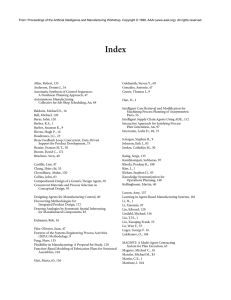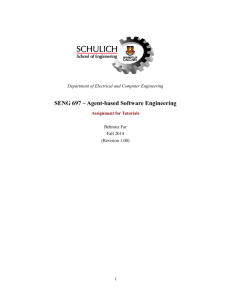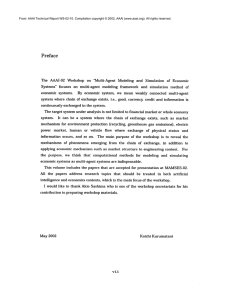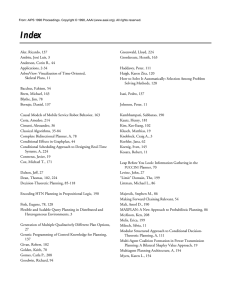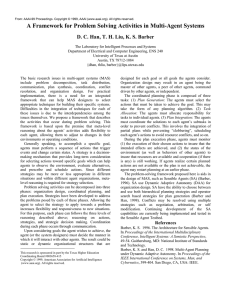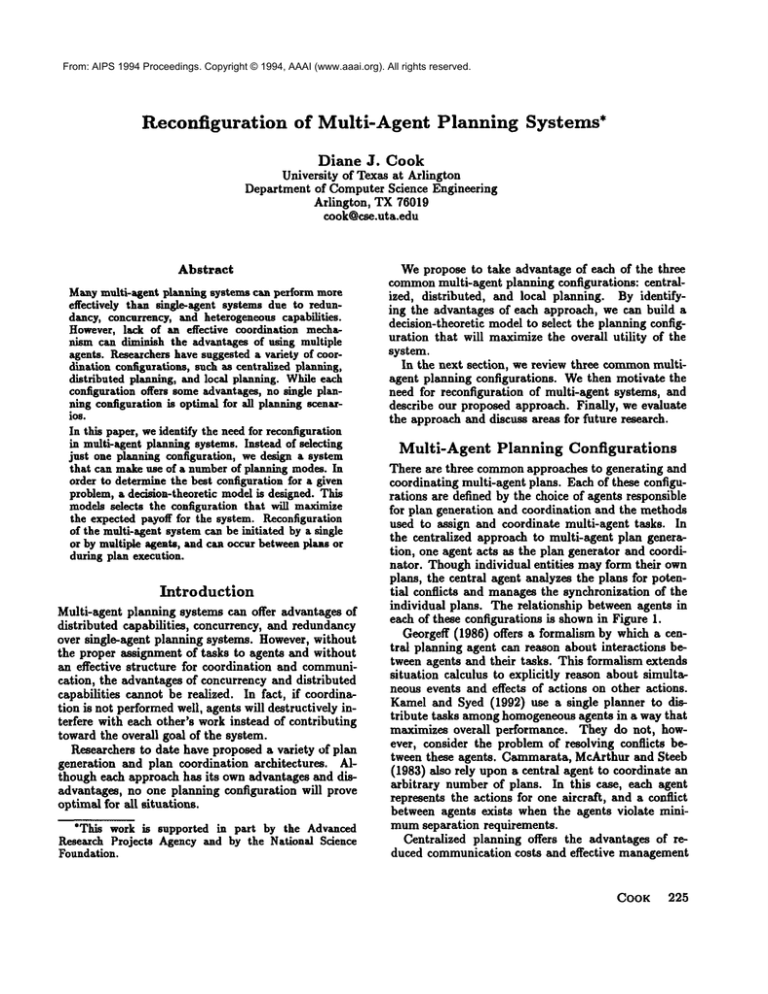
From: AIPS 1994 Proceedings. Copyright © 1994, AAAI (www.aaai.org). All rights reserved.
Reconfiguration
of Multi-Agent
Diane J.
Planning
Systems*
Cook
University of Texas at Arlington
Department of Computer Science Engineering
Arlington, TX 76019
cook@cse.uta.edu
Abstract
Manymulti-agent planning systems ca~ perform more
effectively than single-agent systems due to redundancy, concurrency, and betemgencouscapabilities.
However,lack of an effective coordination mechanism can diminish the advantages of using multiple
agents. Researchers have suggested a variety of coordination configurations, such as centralized planning,
distributed planning, and local planning. While each
configuration offers someadvantages, no single planning configuration is optimal for all planning scenarios¯
In this paper, weidentify the needfor reconfiguration
in multi-agent planning systems. Instead of selecting
just one planning configuration, we design a system
that can makeuse of a numberof planning modes. In
order to determine the best configuration for a given
problem, a decision-theoretic modelis designed. This
models selects the configuration that will maximize
the expected payoff for the system. P~conflguration
of the multi-agent systemcan be initiated by a single
or by multiple agents, and can occur betweenplans or
during plan execution.
Introduction
Multi-agent planning systems can offer advantages of
distributed capabilities, concurrency, and redundancy
over single-agent planning systems. However, without
the proper assignment of tasks to agents and without
an effective structure for coordination and communication, the advantages of concurrency and distributed
capabilities cannot be realized. In fact, if coordination is not performed well, agents will destructively interfere with each other’s work instead of contributing
toward the overall goal of the system.
Researchers to date have proposed a variety of plan
generation and plan coordination architectures.
Although each approach has its own advantages and disadvantages, no one planning configuration will prove
optimal for all situations.
*This work is supported in part by the Advanced
Research Projects Agency and by the National Science
Foundation.
Wepropose to take advantage of each of the three
commonmulti-agent planning configurations: centralized, distributed, and local planning. By identifying the advantages of each approach, we can build a
decision-theoretic model to select the planning configuration that will maximize the overall utility of the
system.
In the next section, we review three commonmultiagent planning configurations. Wethen motivate the
need for reconfiguration of multi-agent systems, and
describe our proposed approach. Finally, we evaluate
the approach and discuss areas for future research.
Multi-Agent
Planning
Configurations
There are three commonapproaches to generating and
coordinating multi-agent plans. Each of these configurations are defined by the choice of agents responsible
for plan ~eueration and coordination and the methods
used to assign and coordinate multi-agent tasks. In
the centralized approach to multi-agent plan generation, one agent acts as the plan generator and coordinator. Though individual entities may form their own
plans, the central agent analyzes the plans for potential conflicts and manages the synchronization of the
individual plans. The relationship between agents in
each of these configurations is shownin Figure 1.
Georgeff (1986) offers a formalism by which a central planning agent can reason about interactions between agents and their tasks. This formalism extends
situation calculus to explicitly reason about simultaneous events and effects of actions on other actions.
Kamel and Syed (1992) use a single planner to distribute tasks among homogeneousagents in a way that
maximizes overall performance. They do not, however, consider the problem of resolving conflicts between these agents. Cammarata, McArthur and Steeb
(1983) also rely upon a central agent to coordinate
arbitrary number of plans. In this case, each agent
represents the actions for one aircraft, and a conflict
between agents exists when the agents violate minimumseparation requirements.
Centralized planning offers the advantages of reduced communication costs and effective management
COOK 225
From: AIPS 1994 Proceedings. Copyright © 1994, AAAI (www.aaai.org). All rights reserved.
CentralizedPlanning
Local Planning
Distributed Planning
’.........
’i .................
L........
]
~
i
,
l
i~i==.=..=..=.=.==.
Figure h Centralized,
Distributed,
of resources and agents (if the central agent has perfect
knowledgeabout the agents’ capabilities and environments). However, the ability to generate and effectively coordinate plans is dependent on a sole agent. If
that agent is damagedor otherwise inaccessible, then
the entire mission is jeopardized. In addition, the traffic surrounding the central agent can cause significant
delays in the overall plan coordination and distribution
process.
In the distributed planning approach, agents are responsible for generating and coordinating their own
actions using information obtained from other agents
about their intentions and approaches. Whenmultiagent planning is performed in a distributed manner,
agents may not have a global view of the environment
and agents’ individual goals, so detecting and resolving interactions is more difllcult. Communicationcosts
tend to be much greater in distributed planning systems, and thus conflict resolution may in some cases
be slower. On the other hand, the approach is more
robust because it does not depend on a single central
agent. Agents can respond more quickly to their own
needs and the needs of neighboring agents when each
decision does not have to be routed through a central
decision maker.
Corkill (19791 has developed a distributed hierarchical planner where agents develop models of their
neighbors. The agents build plans cooperatively by
synchronizing actions at each level of the hierarchical procedural net. In a similar fashion, yon Martial
(19911 allows agents to coordinate activities at a high
level of abstraction before deciding on a specific course
of action. Von Martial detects both positive and neg-
226
POSTERS
°
|~’~|
and Local Planning Configurations
ative interactions between distributed agents. Durfee
and Montgomery(19911 also coordinate plans hierarchically. In this approach, abstract plans are communicated among agents and are decomposed along the
dimensions of space, time, agents, tasks, resources,
and goals only when the potential for conflicts exists
in the abstract plan.
Moehlman and Lesser (19901 demonstrate techniques for explicit negotiation of resources in the
Phoenix fire-fighting
system. Here, agents may only
have local views of the world, but decisions are always
made cooperatively and with a view toward achieving high-priority global goals. While most of the distributed planning systems eventually rely on a ranking of agents, the approach described by Ephrati and
Rosenschein (1993) suggests using a voting mechanism
to collectively select a set of actions from amongan
agent’s preferences. Although distributed plan generation and coordination is an expensive process, Kosoresow (19931 is able to determine bounds for convergence
times in distributed planning systems where agents iteratively post and synchronize their plans. Plans are
revised between postings using a Markovprocess.
In multi-agent systems that use local plan generation
and coordination techniques, decision making is performed exclusively within each agent. Each local agent
may request and send information to other agents, but
the final plan is generated completely by the individual entity. In the most simple case, classical singleagent planning systems may act as local planners in a
multi-agent environment. However, because no collaborative effort toward synchronizing plans is performed,
agents must monitor plan execution and be prepared
From: AIPS 1994 Proceedings. Copyright © 1994, AAAI (www.aaai.org). All rights reserved.
to dynamically adjust their plans during execution.
This approach minimizes the amount of communication required between agents, and does not encounter
plan generation delays due to synchronization. On the
other hand, the performance of plan execution is usually quite poor due to the fact that agents have to work
around other active entities in their environment.
Sycara et al. (1990) adapt single-agent planning
techniques to multi-agent environments by using tezlures to graphically define the complexity and importance of local decisions. By using textures to predict the impact of local decisions on global system
goals, local planning can be performed with a focus
toward achieving and maintaining global goals. Other
researchers have introduced methods of reducing possible conflicts in local planning by introducing execution
policies. Lansky and Fogelsong (1987) identify regions
of activity in the environmentwhere conflicts are likely
to occur, and define constraints for acting within that
region. Shohamand Tennenholtz (1992) define social
laws of interaction that reduce conflicts, in the way
that traffic laws reduce harmful interactions between
vehicles in society.
Reconfiguration
of systems
Reconfiguration of a multi-agent planning system is
not only necessary, it is also a commonpractice in domains such as military plan generation and execution.
A configuration that satisfies one goal may be totally
inappropriate once the goal is satisfied or when the
mission is interrupted by an emergency situation. For
example, Figure 2 shows a Tactical Road March task
that is interrupted by detection of multiple targets. Because of this unforeseen threat, the original planning
and coordination configuration are no longer desirable.
Instead, the agents may need to spread out and cover
the area to flush out all remaining targets. This change
in configuration affects the communicationmechanism,
the method of generating task plans, and the mode of
control.
Weare designing a decision-theoretic model that determines the optimal planning configuration given parameters of the system configuration, the planning environment and the current task. The choice of planning
configuration is guided by the principle of utility maximization. Whichever planning mode maximizes the
expected payoff given the current system parameters
is selected.
The utility for a particular planning configuration is
calculated as a function of the weighted system parameters. The parameters are represented by P~, where c
represents a given planning configuration (centralized,
distributed, or local) and P~ represents one of the six
parameters listed below.
¯ P1 -- The communication
agents,
bandwidth
¯ P2 -- Numberof resources (potential
between
for resource
contention),
¯ Pa = Numberof agents active in the system,
¯ P4 = The number of steps in the plan to be coordinated,
¯ Ps = The reliability of the agents, and
* Ps = The cost of adjusting the plan (if the plans are
not fully synchronized during generation).
The utility of configuration e is calculated as
Utility(e)
= F(w~ P~),
where i ranges over the system parameters. While F
may represent a number of combination functions, we
are experimenting first with a linear combination of
parameters, or
Utility(e)
= E(w~ P~).
i
Wehave implemented plan generation systems for
each of the three main configurations: centralized, distributed, and local planning. The appropriate weights
wi for each of these system parameters can been determined by generating artificial
planning test cases
and calculating the system payoff for each planning
modeas the system parameters change. This decisiontheoretic model can be used to select a configuration
at the beginning of the plan generation. The model
can also be used to reevaluate the current planning
configuration if the system parameters or environment
changes.
All three planning configurations contain the components of detection, planning, and control. The first
aspect of reconflguration is detection of the need to reconfigure. For example, if one agent senses a threat,
it may be useful for several agents to come to the aid
of the threatened entity. The detection algorithm will
alert the system of the need to reconfigure and will
give its rationale. The second aspect of the process is
to plan the reconflguration, tteconfiguration may involve changing the current plans of individual agents.
This transition must be made gracefully, either finding a stopping point in the old plan and initiating the
new, or interleaving steps of the two plans until the
transition is complete. The controller managesthe reconfiguration once it is initiated, makingsure that the
desired new configuration is achieved.
Figure 3 identifies the agent(s) responsible for detecting and controlling a system reconfiguration. For
example, a switch from centralized mode to local mode
is determined by a commandfrom the leader, or by
the end of the current task and the beginning of a
new task in local mode, or by a predetermined time
of day. On the other hand, the system may be reeonfigured from distributed to local modeshould a single
agent request the switch (possibly due to detection of
a nearby threat).
COOK 227
From: AIPS 1994 Proceedings. Copyright © 1994, AAAI (www.aaai.org). All rights reserved.
Figure 2: Need for reconfiguration
228
POSTERS
From: AIPS 1994 Proceedings. Copyright © 1994, AAAI (www.aaai.org). All rights reserved.
Central I
time
or task
]Distribute~_majority
agent
demands
request
Figure 3: Control of reconfiguration
It is possible that detection of a reconfiguration need,
planning for the reconfiguration, and control of reconfiguration may all be executed by different groups of
agents. The table below shows a possibility where a
local agent detects the need for reconfiguration, and a
leader generates and controls the plan for reconfigur~tion. Allowing for all of these combinations is an area
we will pursue in the future.
II
Central
Distributed I Local
Detection
Planning
Control
X
X
X
Conclusions
In this paper, we have described a methodologyfor using a variety of planning configurations in multi-agent
planning systems. Each of the three commonplanning
configurations - centralized planning, distributed planning, and local planning - offer significant advantages
and disadvantages. These tradeoffs prevent one single
configuration from being optimal for all scenarios.
Weare researching a methodfor incorporating all of
these planning configurations into a multi-agent system. By building a decision-theoretic model that calculates the payoff for each configuration, the best configuration for a given plan can be selected. By controlling the switch between planning modes, reconfiguration can be performed between entire plans or during
plan execution.
There are numerousdirections for future research in
this area. Wewill discuss two such extensions in this
section. As suggested in the paper, detection, planning
and control of reconfiguration itself can be initiated
and directed by various groups of agents. Considering
these tradeoffs and incorporating the results into our
system is an area for future research.
This paper described a model that will select one of
the three described planning configurations. In reality,
there are many such configurations.
Many of these
configurations are a hybrid. For example, all agents in
one room maybest be controlled by a central authority,
while agents in another room plan most effectively in
distributed mode. A future version of our model will
be able to select any combination of modes that are
plotted along a continuum of planning configurations.
References
Cammarata, S.; McArthur, D.; and Steeb, R. 1983.
Strategies of cooperation in distributed problem solving. In Proceedings of the Eighth International Joint
Conference on Artificial Intelligence, 767-770.
Corkill, D. D. 1979. Hierarchical planning in a distributed environment. In Proceedings of the Sizth
International Joint Conference on Artificial Intelligence, 168-175.
Durfee, E. H., and Montgomery,T. A. 1991. Coordination as distributed search in a hierarchical behavior
space. IEEE ~Vansactions on Systems, Man, and Cybernetics.
Ephrati, E., and Rosenschein, J. S. 1993. Multi-agent
planning as a dynamic search for social consensus. In
COOK 229
From: AIPS 1994 Proceedings. Copyright © 1994, AAAI (www.aaai.org). All rights reserved.
Proceedings of the International Joint Conference on
Artificial Intelligence, 423-429.
Georgeff, M. 1986. A representation
of events in
multi-agent domains. In Proceedings of the National
Conference on Artificial Intelligence, 125-129.
Kamel, M., and Syed, A. 1992. Task decomposition and plan generation in multiagent domains.
Computer-Integrated Manufacturing 9(1):71-83.
Kosoresow, A. P. 1993. A fast first-cut protocol for
agent coordination. In Proceedings of the Eleventh
National Conference on Arlifieial Intelligence, 23T242.
Lansky, A. L., and Fogelsong, D. 1987. Localized
representation and planning methods for parallel domains. In Proceedings of the National Conference on
Artificial Intelligence, 240-245.
Moehlman, T., and Lesser, V. 1990. Cooperative planning and decentralized negotiation in multifireboss phoenix. In Proceedings of the Workshop on
Innovative Approaches to Planning, Scheduling and
Control, 144-159.
Shoham, Y., and Tennenholtz, M. 1992. On the synthesis of useful social laws for artificial agent societies.
In Proceedings of AAAI, 2T6-281.
Sycara, K.; Roth, S.; Sadeh, N.; and Fox, M. 1990.
Managing resource allocation in multi-agent timeconstrained domains. In Proceedings of the Workshop on Innovative Approaches to Planning, Scheduling and Control, 240-250.
yon Martial, F. 1991. Coordinating Plans of Autonomous Agents. Springer-Verlag.
230
POSTERS

